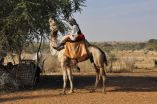(Press-News.org) LOS ANGELES (Oct. 16, 2014) – Male and female brains are not equal when it comes to the biological response to a high-fat diet. Cedars-Sinai Diabetes and Obesity Research Institute scientist Deborah Clegg, PhD, and a team of international investigators found that the brains of male laboratory mice exposed to the same high-fat diet as their female counterparts developed brain inflammation and heart disease that were not seen in the females.
"For the first time, we have identified remarkable differences in the sexes when it comes to how the body responds to high-fat diets," said Clegg. "In the study, the mice were given the equivalent of a steady diet of hamburgers and soda. The brains of the male mice became inflamed and their hearts were damaged. But the female mice showed no brain inflammation and had normal hearts during the diet."
The study was funded by the National Institutes of Health and the findings are published today in the journal Cell Reports.
According to Clegg, the females in the study apparently had a strong protection against the ravages of a high-fat, high-sugar diet that can cause brain inflammation and heart disease. Researchers have linked brain inflammation to overeating, harmful changes in blood sugar levels and to changes in fat tissue composition that can lead to obesity.
"It is as if the brains of females had a chemical force field that kept the dangers of fats and sugars from harming them," said Clegg. "Our data in this study also adds to the growing body of evidence that brain inflammation may be a key factor in the obesity epidemic. These negative brain changes can occur even over a short period of eating fatty and sugary food and clearly affected males much more than females."
Clegg said the research suggests that one size may not fit all when it comes to nutritional guidance aimed at keeping patients from becoming dangerously overweight. An occasional high-fat meal may be OK for women, but something men at risk for obesity will need to avoid always.
"These findings on how the brains and bodies of males and females respond so differently to nutrients suggests we have to reconsider whether the diets and drugs we recommend for managing obesity may need to be sex-specific to be more effective," said Richard Bergman, PhD, director of the Diabetes and Obesity Research Institute.
Investigators discovered one encouraging sign for males: They could manipulate the brain of the mice in such a way they would develop the anti-inflammation characteristics of the female brain.
"When we caused the male brain to resemble the female brain in chemical composition, it was protected from the dangerous inflammatory effects a high-fat diet created in the normal male brain," said Clegg. "It provided more proof that the female brain inherently possesses certain chemical qualities that protects her from the dangers of a high-fat diet."
Clegg said the next step in the research of sex differences and nutrition is to investigate these initial findings in humans. Identifying which factors appear to protect female brains from high-fat diet inflammation, and their hearts from disease, could significantly impact the future treatment of obesity and diabetes for all patients.
INFORMATION: END
High-fat meals could be more harmful to males than females, according to new obesity research
2014-10-17
ELSE PRESS RELEASES FROM THIS DATE:
Divide and conquer: Novel trick helps rare pathogen infect healthy people
2014-10-17
New research into a rare pathogen has shown how a unique evolutionary trait allows it to infect even the healthiest of hosts through a smart solution to the body's immune response against it.
Scientists at the University of Birmingham have explained how a particular strain of a fungus, Cryptococcus gattii, responds to the human immune response and triggers a 'division of labour' in its invading cells, which can lead to life-threatening infections.
Once inhaled, the pathogen can spread through the body to cause pneumonia or meningitis. The outbreak strain of this fungus ...
New pill-only regimens cure patients with hardest-to-treat hepatitis C infection
2014-10-17
(Vienna, October 17, 2014) Two new pill-only regimens that rapidly cure most patients with genotype 1 hepatitis C (HCV) infection could soon be widely prescribed across Europe. Two recently-published studies1,2 confirmed the efficacy and safety of combination therapy with two oral direct-acting antiviral agents (DAAs), with around 90% of patients cured after just 12-weeks of treatment.
At the 22nd United European Gastroenterology Week (UEG Week 2014) in Vienna, Austria, Professor Michael P. Manns from Hannover Medical School in Germany will be presenting this data and ...
Explosion first evidence of a hydrogen-deficient supernova progenitor
2014-10-17
A group of researchers led by Melina Bersten of the Kavli Institute for the Physics and Mathematics of the Universe recently presented a model that provides the first characterization of the progenitor for a hydrogen-deficient supernova. Their model predicts that a bright hot star, which is the binary companion to an exploding object, remains after the explosion. To verify their theory, the group secured observation time with the Hubble Space Telescope (HST) to search for such a remaining star. Their findings, which are reported in the October 2014 issue of The Astronomical ...
NASA's Hubble finds extremely distant galaxy through cosmic magnifying glass
2014-10-16
Peering through a giant cosmic magnifying glass, NASA's Hubble Space Telescope has spotted a tiny, faint galaxy -- one of the farthest galaxies ever seen. The diminutive object is estimated to be more than 13 billion light-years away.
This galaxy offers a peek back to the very early formative years of the universe and may just be the tip of the iceberg.
"This galaxy is an example of what is suspected to be an abundant, underlying population of extremely small, faint objects that existed about 500 million years after the big bang, the beginning of the universe," explained ...
NASA begins sixth year of airborne Antarctic ice change study
2014-10-16
NASA is carrying out its sixth consecutive year of Operation IceBridge research flights over Antarctica to study changes in the continent's ice sheet, glaciers and sea ice. This year's airborne campaign, which began its first flight Thursday morning, will revisit a section of the Antarctic ice sheet that recently was found to be in irreversible decline.
For the next several weeks, researchers will fly aboard NASA's DC-8 research aircraft out of Punta Arenas, Chile. This year also marks the return to western Antarctica following 2013's campaign based at the National Science ...
NASA spacecraft provides new information about sun's atmosphere
2014-10-16
NASA's Interface Region Imaging Spectrograph (IRIS) has provided scientists with five new findings into how the sun's atmosphere, or corona, is heated far hotter than its surface, what causes the sun's constant outflow of particles called the solar wind, and what mechanisms accelerate particles that power solar flares.
The new information will help researchers better understand how our nearest star transfers energy through its atmosphere and track the dynamic solar activity that can impact technological infrastructure in space and on Earth. Details of the findings appear ...
New Univeristy of Virginia study upends current theories of how mitochondria began
2014-10-16
Parasitic bacteria were the first cousins of the mitochondria that power cells in animals and plants – and first acted as energy parasites in those cells before becoming beneficial, according to a new University of Virginia study that used next-generation DNA sequencing technologies to decode the genomes of 18 bacteria that are close relatives of mitochondria.
The study appears this week in the online journal PLOS One, published by the Public Library of Science. It provides an alternative theory to two current theories of how simple bacterial cells were swallowed ...
Shrinking resource margins in Sahel region of Africa
2014-10-16
The need for food, animal feed and fuel in the Sahel belt is growing year on year, but supply is not increasing at the same rate. New figures from 22 countries indicate falling availability of resources per capita and a continued risk of famine in areas with low 'primary production' from plants. Rising temperatures present an alarming prospect, according to a study from Lund University in Sweden.
The research has investigated developments between the years 2000 and 2010 in the Sahel belt, south of the Sahara Desert. Over this ten-year period, the population of the region ...
How a molecular Superman protects the genome from damage
2014-10-16
Cold Spring Harbor, NY – How many times have we seen Superman swoop down from the heavens and rescue a would-be victim from a rapidly oncoming train?
It's a familiar scenario, played out hundreds of times in the movies. But the dramatic scene is reenacted in real life every time a cell divides. In order for division to occur, our genetic material must be faithfully replicated by a highly complicated machine, whose parts are tiny enough to navigate among the strands of the double helix.
The problem is that our DNA is constantly in use, with other molecular machines ...
First detailed map of aboveground forest carbon stocks in Mexico unveiled
2014-10-16
Available for download today, the Woods Hole Research Center (WHRC) and Allianza MREDD+ released the first detailed map of aboveground forest carbon stocks of Mexico. This carbon stock inventory is very valuable for Mexico, as one of the first tropical nations to voluntarily pledge to mitigation actions within the context of the United Nation's Reducing Emissions from Deforestation and forest Degradation (REDD+) program.
The hectare-scale map is the result of a collaboration led by WHRC scientists Josef Kellndorfer and Oliver Cartus with Mexico's National Forestry Commission ...






